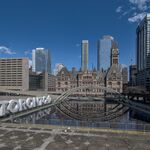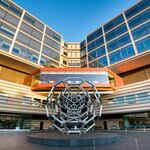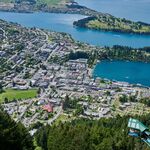CalgaryTiger
Senior Member
Are we all forgetting that CT acknowledges that there is not enough buses or drivers for their ideal level of service. The riders are there, the drivers and buses are not.
|
|
|
This is because the 17 Ave SE corridor has 3 other routes besides the MAX Purple, with the 87 and 440 providing local-style service to Marlborough and Franklin respectively and the 1 using all Purple stops between 52 Street and downtown. If the 1 were shortened to Bowness-downtown then the MAX Purple would be more frequent.The max purple line is the only one that doesn’t run all day and has low frequency. The other three max lines run all day and have higher frequencies.
The driver situation isn’t as bad as it used to be, since CT has gone thru several hiring sprees in 2022-23. Fleet is the #1 problem right now. 117 buses are going to be 20+ years old this year and two thirds of the articulated fleet + every single one of the shuttles are past due for replacement as well. While we’re not as screwed as Edmonton (unreliability in their battery-electric fleet has reached the point where only half of them actually see service nowadays, and their diesel fleet is aging at a similar pace to ours but they only have the budget for 22 replacements), service improvements are going to be gradual at best.Are we all forgetting that CT acknowledges that there is not enough buses or drivers for their ideal level of service. The riders are there, the drivers and buses are not.
Maybe it is naive to think the city can pat its head and rub its stomach... I love the Main Streets and other similar projects but if our bus fleet is in such poor condition. Maybe we do need to be doing less city building and more city maintaining. If people start asking where all the city building projects went, point directly to the province who seems to be taking more and giving less.This is because the 17 Ave SE corridor has 3 other routes besides the MAX Purple, with the 87 and 440 providing local-style service to Marlborough and Franklin respectively and the 1 using all Purple stops between 52 Street and downtown. If the 1 were shortened to Bowness-downtown then the MAX Purple would be more frequent.
The driver situation isn’t as bad as it used to be, since CT has gone thru several hiring sprees in 2022-23. Fleet is the #1 problem right now. 117 buses are going to be 20+ years old this year and two thirds of the articulated fleet + every single one of the shuttles are past due for replacement as well. While we’re not as screwed as Edmonton (unreliability in their battery-electric fleet has reached the point where only half of them actually see service nowadays, and their diesel fleet is aging at a similar pace to ours but they only have the budget for 22 replacements), service improvements are going to be gradual at best.
This is the kind of information you'd think it would be relatively easy to find, but isn't. Surely there's some public information about fleet plans, conditions and characteristics, budgets priorities (that are understandable to the public), progress reports etc.Our bus fleet is in shambles right now, so the existing level of service is honestly a miracle. I really want to see more funding for buses because the ones we have on the way will pretty much all be followed by the beaters being retired.
While a net positive to be sure I wouldn’t count on big gains. More like a few LRVs not a couple new LRT stations.Not only would those park and ride lots get developed, but they’d get money by selling them and they could use that money towards other transit infrastructure.
If limited funds become an issue the city can do easy things that don't cost money. Things like selling off some of the park and ride sites so they can be developed.
While a net positive to be sure I wouldn’t count on big gains. More like a few LRVs not a couple new LRT stations.
Would have to look at a service map but Westbrook may already be serviced (and taxpayers paid for those services). Anderson was judged to require $35 million to build out services out front. Not looking at relative size either.Luckily, we actually have something of a good guide on this; a bus is $750K (a methane powered bus is a few huindred thousand more). A light rail train (full train) is I think $10M or so. Westbrook was recently repurchased for $43M.
I know the 7 and 13 all too well. What you describe is true, it is so close to downtown yet so inefficient. I bought a bike and ride year-round. I think you could also add a 7A that serves the more dense part of the route (downtown and beltline, maybe down 14 St to 33 Ave where it could turn around using 34 Ave and head back down 14 St).Luckily, we actually have something of a good guide on this; a bus is $750K (a methane powered bus is a few huindred thousand more). A light rail train (full train) is I think $10M or so. Westbrook was recently repurchased for $43M. I don't know how feasible it is (and it's not in the 'quick money' category) but I'd be interested in seeing the City engage in some sort of partnership in park and ride redevelopment where rather than a one-time cash infusion, we got a revenue stream from the property in the form of a lease or rent, that could be earmarked for transit operations. It's always easier to find money to make something new that can be photographed and have a ribbon cutting, operations is where we're falling short. We can spend tens of millions of dollars building fancy bus shelters, but can't come up with a couple million extra to run buses frequently enough that people don't need to wait.
There do exist actual near-free operational improvements, like stop consolidation and all-door boarding, particularly for busy routes such as the 301 or some MAX routes. Every time a bus stops, it has to slow down, stop, open the doors, let people on, close the doors, then speed up and get back in traffic. Even letting one person on can take a fair amount of time. Similarly, with most riders using passes, tickets or e-tickets, if we let riders board on all the doors (the front door would still allow cash sales and the driver would just always give a transfer), we can cut the time the bus is stopped by 50% -- this is mostly important when the stop is busy, but guess what? by definition, there are more riders on routes with busy stops and at busy times of the day.
These both seem small, but they add up. From 78th Ave N to Suncor, the 3 and the 301 travel the exact same route, but the 301 just makes fewer stops. At 7 AM, the 3 is scheduled to take 30 minutes and the 301 is scheduled to take 21, 70% of the time. At noon, it's 28 and 19 minutes (67%), even at 10 PM it's 22 and 16 minutes (72%).
As a worked example,. in the AM peak the #7 goes from the pancake house at 54th Ave to downtown; it takes 32 minutes to go downtown, then spends 12 minutes driving the loop through downtown, then another 32 back out and then a 12 minute break for the driver. That's an 88 minute round trip. The buses run every 22 minutes. There is literally a bus stop every 2 blocks on 20th St, then a bus stop every single block on 33rd Ave. If you want to go to the middle of downtown from the end of the line, it takes 49 minutes (11 minute average wait, 32 minute to downtown, 6 minutes to go halfway through downtown). From Marda Loop, it's 39 minutes.
If you speed up the time spent travelling to downtown to 70% of current time (I'm not including the time in the downtown) with fewer stops like the 301, it takes 10 minutes less from the end of the line, and 6.6 minutes less from Marda Loop. But that's not all. Since the bus is travelling faster, the full round trip (including the same 12 minute dwell for the driver at the end of the line) is now 69 minutes. We know the buses run every 22 minutes now and the loop takes 88 minutes, which means that there must be 4 buses serving this route. If the route takes only 69 minutes, the same four buses mean there's a bus every 17.2 minutes.
As it happens, another way of making service better on this route would be to buy another bus and assign another driver. Turns out that 88 minutes / 5 buses is a bus every... 17.6 minutes. The speed up not only saves riders a big chunk of their time on the bus, it's also like a new bus has appeared for free. A 25% service increase. For free. The trip from the end of the line goes from 49 minutes to 37; the trip from Marda Loop goes from 39 minutes to 30.
The tradeoff is that some people will have to walk farther; this is true. But it's not as many as you think; some stops are busier than others. At 20th St and 50th Ave, there's 2 high schools plus the connection to the #13 to Mount Royal. At 20th St and 48th Ave? (Yes, the bus stops literally 200m away.) Not as much. And even if you do have to walk a couple of minutes further, for most people that would be a fair trade to save 9-12 minutes on the overall trip.
You mention Co-ops, why doesn't the city do what Co-op is doing and leverage its parking lots. Find a partner to develop something like co-op housing, affordable units, etc. Even get CMLC involved and using their placemaking and developer relationships.I’d prefer they be leveraged for high-ish density co-ops or low rent schemes
Not only would those park and ride lots get developed, but they’d get money by selling them and they could use that money towards other transit infrastructure.
The first step is for Transit's strategic direction to declare free park-and-ride is not a tool they will use, instead putting the land to work either through revenue recovery (paid parking) or trip-generation (redevelopment).While a net positive to be sure I wouldn’t count on big gains. More like a few LRVs not a couple new LRT stations.
I’d prefer they be leveraged for high-ish density co-ops or low rent schemes personally, as the city for whatever reason has a harder time using money for such things than transferring non-money assets.




